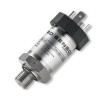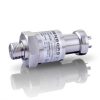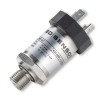Marine approved pressure transmitters with 4-20mA output for critical ship management systems including engines, cargo tanks, ballast control, and fuel gauging. ATEX options available.
This range of marine approved pressure transmitters is specifically engineered and certified to meet the rigorous demands of maritime operations. These instruments provide crucial pressure and level data for a wide array of shipboard systems, including main engine monitoring, cargo and fuel tank gauging, ballast water management, freshwater and wastewater systems, and HVAC/cooling circuits. Featuring robust 4-20mA outputs for reliable signal transmission and options for ATEX intrinsic safety certification for hazardous environments on tankers, along with versatile mounting solutions for liquid level applications, these transmitters ensure operational safety, efficiency, and regulatory compliance for modern fleets.
 DMK457 Marine Approved Pressure Transmitter - Marine approved pressure transmitter with 4-20mA current loop output for shipbuilding with optional CuNiFe housing for sea-water compatibility
DMK457 Marine Approved Pressure Transmitter - Marine approved pressure transmitter with 4-20mA current loop output for shipbuilding with optional CuNiFe housing for sea-water compatibility DMK 458 Seawater Low Range Pressure Transmitter - Sea water corrosion resistant low range pressure transmitter for marine, ship and offshore engineering.
DMK 458 Seawater Low Range Pressure Transmitter - Sea water corrosion resistant low range pressure transmitter for marine, ship and offshore engineering. LMK 487 Submersible Ballast Tank and Draught Level Pressure Transmitter - A 22mm diameter titanium body seawater depth and level probe with a 4-20mA output with Lloyds and DNV-GL ship approval, for monitoring the quantity of ballast or the draft of a ship’s hull.
LMK 487 Submersible Ballast Tank and Draught Level Pressure Transmitter - A 22mm diameter titanium body seawater depth and level probe with a 4-20mA output with Lloyds and DNV-GL ship approval, for monitoring the quantity of ballast or the draft of a ship’s hull. DMP457 Marine Approved Pressure Transmitter - Marine approved stainless steel diaphragm pressure transmitter with 4-20mA current loop output for shipbuilding in ranges from 100mb to 600 bar gauge or absolute.
DMP457 Marine Approved Pressure Transmitter - Marine approved stainless steel diaphragm pressure transmitter with 4-20mA current loop output for shipbuilding in ranges from 100mb to 600 bar gauge or absolute.
- Lube oil pressure sensor for use on ship engines to measure up to 10 bar
- 2 bar g sea water pressure transmitter for marine engine cooling system
- Monitoring high-pressure seawater pumps on merchant vessels with submersible pressure transmitters
- Marine air lubrication system submersible seawater resistant air pressure transmitter
- Marine approved atmospheric pressure sensor
- -10…30 kPa g compound range inert gas pressure transmitter for ship IG system
- Ship lubrication oil pump pressure transmitter with DNV/GL marine approval certificate
 Sea Water Resistant Ship Use Certified Pressure Transmitters - These pressure transmitters are specifically engineered to handle the harsh conditions found in shipboard and marine environments. Constructed with corrosion-resistant wetted parts suitable for seawater and certified for marine use
Sea Water Resistant Ship Use Certified Pressure Transmitters - These pressure transmitters are specifically engineered to handle the harsh conditions found in shipboard and marine environments. Constructed with corrosion-resistant wetted parts suitable for seawater and certified for marine use Ship Use Certified Pressure Transmitters - Marine certified 4-20mA pressure transmitters are essential for monitoring critical systems on ships. Approved by classification societies like Lloyd's Register and DNV to ensure reliability in demanding marine environments.
Ship Use Certified Pressure Transmitters - Marine certified 4-20mA pressure transmitters are essential for monitoring critical systems on ships. Approved by classification societies like Lloyd's Register and DNV to ensure reliability in demanding marine environments.
Find out more about Marine Approved Pressure Transmitters to determine which product options and capabilities will best meet your application requirements.
Marine approved pressure transmitters are indispensable components within the sophisticated ship management control systems found on modern vessels. These devices are not standard industrial transmitters; they must carry specific certifications from recognized maritime classification societies such as DNV, ABS, Lloyd’s Register, Bureau Veritas, or RINA. These approvals verify their design, construction, and performance meet the stringent demands of harsh marine environments, which include constant vibration, fluctuating temperatures, saltwater corrosion, and electromagnetic interference. The certification ensures reliability and safety in critical applications that are essential for the vessel’s operation, the safety of the crew, and the protection of the marine environment.
The prevalent 4-20mA analog output signal is a common feature in these marine-certified transmitters. This type of signal is favored in maritime applications due to its inherent robustness against electrical noise, which can be abundant in machinery spaces and areas with large electrical installations on board. Furthermore, the 4-20mA current loop allows for long-distance signal transmission with minimal degradation, enabling sensors located in remote parts of the ship, such as engine rooms or distant cargo tanks, to reliably communicate with centralized control and monitoring systems on the bridge or in the engine control room.
Applications for marine approved pressure transmitters are diverse and crucial. Within marine engine systems, they monitor vital parameters such as lubricating oil pressure, coolant pressure, fuel supply pressure, and even exhaust gas backpressure, providing critical data for engine management, performance optimization, and early fault detection to prevent catastrophic failures. For cargo operations, especially on tankers and bulk carriers, these transmitters are key for monitoring pressure within cargo storage tanks, ensuring structural integrity and safe containment of contents. This includes monitoring inert gas system pressures used to prevent explosions in tanks carrying flammable liquids.
Fuel gauging relies heavily on pressure transmitters to determine fuel levels in service and storage tanks, which is essential for accurate consumption calculations, voyage planning, and maintaining optimal trim. Similarly, they are employed for managing fresh water storage, monitoring levels in potable water tanks to ensure an adequate supply for the crew and ship services. Wastewater management systems also utilize these transmitters to monitor levels in holding tanks and pressures within treatment systems and discharge lines, ensuring compliance with international maritime pollution regulations. Heating, ventilation, air conditioning (HVAC), and various cooling systems onboard ships, including seawater cooling circuits for main engines and auxiliary machinery, depend on pressure transmitters to maintain operational efficiency and prevent system failures. Ballast tank control, critical for a vessel’s stability, trim, and stress distribution, uses pressure transmitters to precisely measure the level of water in ballast tanks, feeding data to automated systems that manage ballast operations during cargo loading, unloading, and voyages.
For specialized vessels such as oil, LNG (Liquefied Natural Gas), and LPG (Liquefied Petroleum Gas) tankers, the risk of flammable atmospheres necessitates the use of ATEX or IECEx certified intrinsically safe pressure transmitters. These certifications ensure that the transmitters are designed to operate with very low electrical and thermal energy under fault conditions, preventing them from becoming an ignition source in potentially explosive environments. This is a non-negotiable safety requirement for handling volatile cargoes.
When it comes to liquid level measurement in tanks, marine approved pressure transmitters offer several installation methodologies tailored to specific needs and tank designs. Mounting the transmitter onto an external flange at the base or side of a tank is a common approach, allowing for easy access and maintenance without needing to enter the tank. For direct level sensing, submersible pressure transmitters are designed to be lowered directly into the liquid. These units feature robust, sealed housings and specialized cable materials resistant to the specific liquids being measured, whether it be seawater, fuel, or various chemical cargoes. Another sophisticated method involves mounting the pressure transmitter inside a submerged guide pipe or stilling well within the tank. This configuration is particularly beneficial on moving vessels as it dampens the effects of sloshing or turbulence within the tank, ensuring a more stable and accurate level reading, which is vital for dynamic positioning systems or when precise cargo measurements are required during transit. The choice of diaphragm material for these transmitters is also a critical consideration, with options like ceramic or specific alloys available to ensure compatibility with corrosive or aggressive media.
